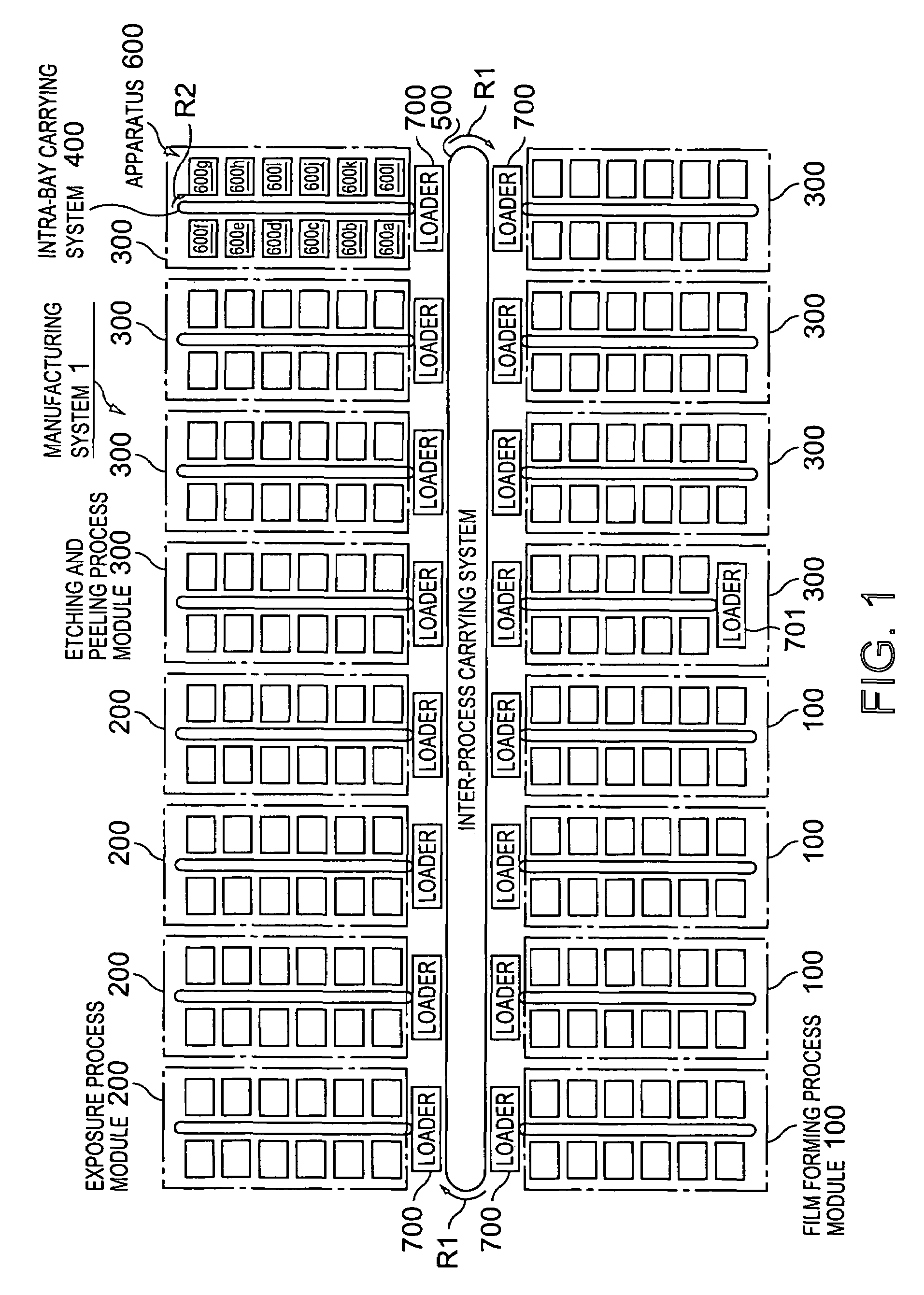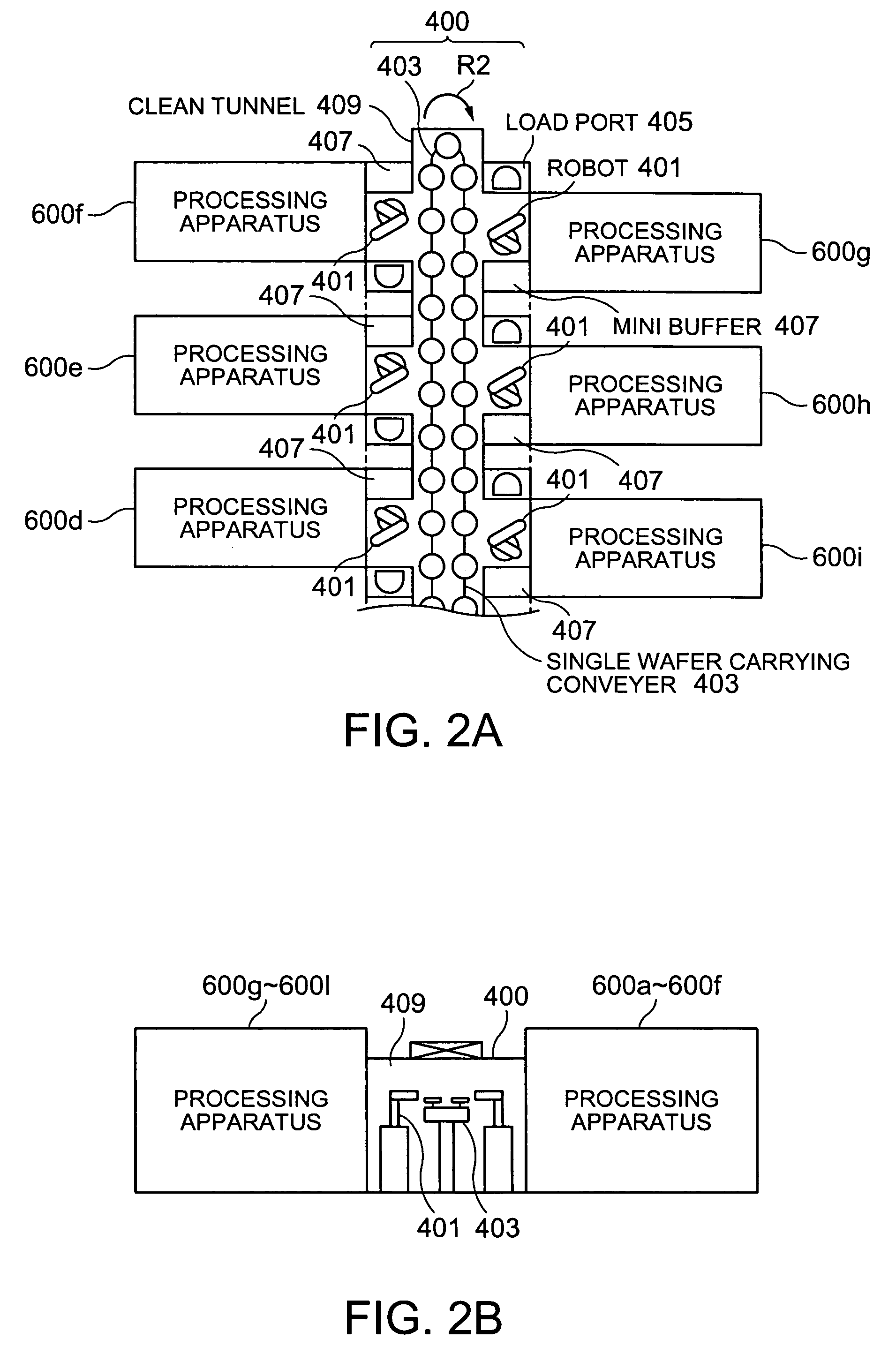[0011]According to the above construction, by using a container capable of storing a plurality of intermediate products as a unit, the containers are carried between the process modules, and the intermediate products are removed from the containers in each
process module. Then, the intermediate products are carried within each process module in a
single product state. The plurality of processing means are arranged substantially in the carrying direction of the intermediate products in accordance with the order of processes to be performed on the intermediate products, without arranging the plurality of processing means for performing the same kinds of processes on the intermediate products in a group. For this reason, when the intermediate products are carried in the carrying direction, the plurality of processing means can efficiently perform the plurality of processes, respectively. Therefore, it is not necessary to repeatedly circulate the intermediate products within the process modules as in the conventional art, and for example, through one circulation, the intermediate products are efficiently subjected to a series of continuous processes. In each process module, since the intermediate products are carried in a
single product state, not in a container unit, it is possible to manufacture a variety of intermediate products in small quantities.
[0013]According to the above construction, the intermediate products can be temporarily stored, corresponding to the carrying situation of the intermediate products between the process modules by the inter-process carrying means or to the carrying situation of the intermediate products within the process modules by the intra-process carrying means. Therefore, the transfer means can efficiently transfer the intermediate products between the inter-process carrying means and the intra-process carrying means, corresponding to the carrying situation of the intermediate products being carried.
[0015]According to the above construction, since the plurality of intermediate products to be processed in the same next process module are stored in a bundle in the same container and are then carried between the process modules, it is possible to more efficiently carry the intermediate products, compared with cases in which the plurality of intermediate products to be processed in different next process modules are mixed and then the intermediate products are carried between the process modules. Furthermore, according to the above construction, since it is possible to minimize the wait time when the maximum number of intermediate products capable of being stored in the container is reached and then the intermediate products are carried in a container unit, that is, the wait time for completion of processes on other intermediate products to be stored in the same container, it is possible to considerably reduce the
lead time, compared with the conventional case.
[0017]According to the above construction, it is not necessary to repeatedly circulate the plate-shaped intermediate products within the process modules as in the conventional case, and, for example, through only one circulation, it is possible to efficiently perform a series of continuous processes thereon. Accordingly, since the carrying time of the plate-shaped intermediate products is shortened, particles are hardly attached to the plate-shaped intermediate products. Furthermore, since the carrying time is shortened, it is also possible to considerably reduce the
lead time.
[0019]According to the above construction, it is not necessary to repeatedly circulate the semiconductor wafers within the process modules as in the conventional case, and, for example, through only one circulation, it is possible to efficiently perform a series of continuous processes thereon. Accordingly, since the carrying time of the semiconductor wafers is shortened, particles are hardly attached to the semiconductor wafers. Furthermore, since the carrying time is shortened, it is also possible to considerably reduce the
lead time.
[0021]According to the above construction, it is not necessary to repeatedly circulate the substrates for
liquid crystal display devices within the process modules as in the conventional case, and, for example, through only one circulation, it is possible to efficiently perform a series of continuous processes thereon. Accordingly, since the carrying time of the substrates for the
liquid crystal display devices is shortened, particles are not attached well to the substrates for
liquid crystal display devices. Furthermore, since the carrying time is shortened, it is also possible to considerably reduce the lead time.
 Login to View More
Login to View More  Login to View More
Login to View More 


